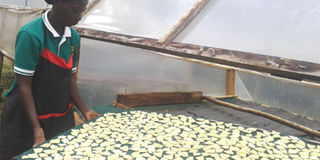Pineapple crisps are a money maker for Nakiwala

Fatuma Nakiwala drying her pineapple crisps at her home in Kayunga District. Photo by Fred Muzaale
Sixteen years ago, Fatuma Nakiwala a resident of Kisega Village in Kangulumira Sub-county, Kayunga District, was a poor woman.
She was a subsistence farmer who grew pineapples and other food crops. She would sell fresh pineapples to get money to meet her basic needs. Annually, she would make Shs1.2m from the two planting seasons which was not enough to address her needs.
“There are many pineapple farmers in Kangulumira Sub-county, so buyers would pay us little money during the peak of the harvesting season,” the 44-year-old Nakiwala says.
However, the year 2000 was a turning point for the mother of four. This was the time when she decided to switch to selling pineapple crisps.
She conceived the idea after receiving some training from a friend, who was already engaged in solar pineapple drying. The friend, she adds, told her about some Europeans who wanted to buy dried pineapples.
“I decided to invest my little savings of Shs350,000 to start the venture,” she says, adding, she bought a solar dryer at Shs250,000.
Nakiwala started out by selling 15 kilogrammes of dried pineapples which would fetch her about Shs75,000 per week. That marked the end of her selling fresh fruits on the market. She utilized her crop to supply to her new found cash cow.
Nakiwala says for the first one and a half years, she dried pineapples from her garden until 2003, when she started buying from other farmers as well to meet the market demand. “I buy fruits from organic farmers because the buyers don’t want pineapples which are sprayed with artificial pesticides or fertilisers,” she says. Since then, Nakiwala has expanded her value addition business.
The numbers of dryers have increased from the initial one to 15. She now employs three people who help her peel, cut into pieces and the place the trays with chips in the dryers.
Market
Although Nakiwala dries the pineapples, she doesn’t sell them to the buyers directly. She explains that she sells them to the Fruits of the Nile, which in turn exports it to the European Union market.
“I cannot sell directly to the European market because I don’t have an exporting license. But I hope to attain it so that I eliminate the middlemen. This would increase my profits,” she says.
Although she sells a kilo of dried pineapples to the company at Shs10,000, Nakiwala is optimistic that she would make more if she eliminated middlemen.
In a week, she sells twice to Fruits of the Nile, who in most cases pay her cash. I earn about Shs400,000 per week from my enterprise. She adds that she began selling in small quantities to buyers from Germany.
Achievements
There is no doubt that Nakiwala’s fortunes have improved greatly. She is able to fend for her family and has build herself a home.
Challenges
Nakiwala’s biggest challenge comes during the rainy season. Without the sun, she loses some of her fruits because they don’t dry fast.
Spoilt fruits are substandard and fetch very low prices. She says, however, that she has plans of buying a solar drier which can also use wood fuel to generate heat.
Secondly, the high demand for fresh pineapples, especially off season, pushes pineapple prices up, which in turn cuts on her profit margin.
Plans
Nakiwala plans to expand her venture to 30 driers and also plant more pineapples.
Drying pineapples
High level of hygiene should be observed during this process.
• Harvest ripe pineapples
• Wash and then peel off the skin
• Slice the pineapple into thin slices. This is important so that they dry at once.
• Then place the slices on trays and then put the trays in the driers and then close.
• After about two to three days under bright sunshine the slices are dry but they can take four days when the sunshine is poor.
• Remove the dry slices and package them in the polythene bags.
Process
Most producers use simple, timber-framed ‘cabinet’ driers, which are covered with UV-stabilised polythene, with mesh-covered vents at the base and top. Sliced fruit is laid out on plastic mesh trays inside the drier, and dried by the sun. Each drier can produce between five and 12 kg of dried fruit every two days, in good sunshine.
The dried fruit is packed into polythene bags, and then put into hessian sacks which are taken by van to the Fruits of the Nile factory in Njeru. At the factory, the fruit is inspected by the Quality Supervisor, and any substandard production is rejected. The fruit is re-sorted to remove what is discoloured or dusty, or shows signs of insect damage. The fruit is re-packed in double-layered polythene bags, frozen down to -150C, then packed in boxes for export.
Did you know?
What Ugandans often do not realise is that pineapples were brought to Uganda, they are not endemic to Uganda, they came to Uganda from Asia via the trade routes from the Swahili Coast of Kenya, however Uganda has perfected them with its soil and weather.




